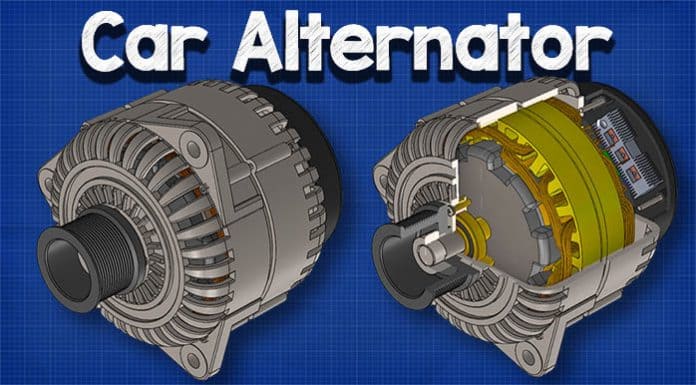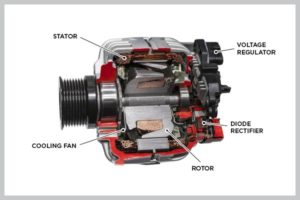
Introduction
Battery Generators alternator or dynamo
The alternator is a device to convert mechanical energy from the automobile engine into electrical energy the alternator replaces in the battery current used in starting the engine and also supplies current for the operation of electrical devices such as the ignition system, light, radio, etc.
The Alternator or dynamo is usually mounted on the side of the engine block it is driven by the engine fan belt.
Alternators produce the power for the electrical systems of modern vehicles. Previously, DC generators or dynamos were used instead. But after the development of the alternator, they replaced DC dynamos since alternators are more robust and lightweight.
Despite this need to convert the current from AC to DC, an alternator is still used as it lacks the complicated commutation present in a DC generator.
This particular type of generator used in the vehicle is known as an automotive alternator
The components of an alternator are geared toward providing the right type and right amount of power to the vehicle. Your car’s charging system contains many parts, but these are the main components and their functions:
Battery Generators alternator or dynamo
Components of an alternator
With this type of electricity, the electrons flow in just one direction, this is the same as the electricity you get from a battery.
Since the electrical system of motor vehicles requires direct current and not alternating current, an alternator is used alongside a diode rectifier to convert the current from AC to DC.

the alternator converts the Alternating current into direct current via a rectifier. The output voltage of the alternator varies with the speed of the car, so the alternator also uses a regulator to limit this and maintain a near-constant output
Rotor and stator
The rotor and stator are the electricity-producing components of an alternator. The rotor, a cylindrical piece surrounded in magnets, spins inside of the stator, which holds a fixed set of conductive copper wiring. The movement of the magnets over the wiring is what ultimately creates electricity. the rotor is mounted on a shaft supported in the front by a ball bearing and in the rear by a needle bearing a pulley is keyed at the front end of the shaft to turn by means of an engine-driven by belt.
Voltage regulator
The voltage regulator oversees the power the alternator makes. It monitors the level of voltage that is output to the battery and delivers power to the rest of the vehicle.
Diode rectifier
The diode rectifier converts the voltage from the alternator into a form that can be used by the battery to recharge. the diode is an electric device that permits current to flow through it in one direction only the three positive rectifiers are pressed into a heat sink
Cooling fan
Alternators give off a lot of heat and need to be cooled to operate efficiently. While they’re built with vents and aluminum casing to better release heat, they’re also equipped with rotating fans for added cooling. New alternator models have internal cooling fans, whereas older versions tend to have external fan blades.
thanks to read this artical


[…] Alternators […]
[…] Alternators […]
[…] Alternators […]